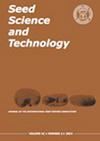沿海平原蜂房(Balduina angustifolia)萌发对光周期、温度和赤霉素酸的响应
IF 3
4区 农林科学
Q2 AGRONOMY
引用次数: 3
摘要
沿海平原蜂窝(Balduina angustifolia)在生态系统恢复和传粉者保护项目中未得到充分利用。在2007年和2016-2018年期间,从美国佛罗里达州不同种群收集的种子用于实验,评估了0或12小时光周期、季节和标准温度、0- 5000 ppm赤霉素(GA)或源种群(佛罗里达州西北部、中部和南部)对种子萌发的影响。佛罗里达中部种子在除夏季(4%)外的所有季节温度下的发芽率都很高(62-74%),且不受光周期的影响。西北两个种群的发芽率不同,温(35/25和30/20°C)高于冷(25/15和20/10°C)(63-72%比9-36%)。在一项为期一年的移动实验中,来自佛罗里达州中部、中南部和南部的种子在所有季节和恒定温度下的发芽率相似,而佛罗里达州西北部的种子在冬季温度下发芽率降低。暴露于GA后,4个群体中有2个和4个群体中有3个的种子在1年龄和5天龄时萌发率分别有所提高。沿海平原蜂窝在区域尺度上有不同的温度要求,在局部尺度上有不同的休眠水平。本文章由计算机程序翻译,如有差异,请以英文原文为准。
Germination of coastalplain honeycombhead (Balduina angustifolia) in response to photoperiod, temperature and gibberellic acid
Coastalplain honeycombhead (Balduina angustifolia) is underutilised in ecosystem restoration and pollinator conservation projects. Seeds collected from different populations throughout Florida, USA during 2007 and 2016-2018 were used in experiments that evaluated the effects of a 0 or 12-hour photoperiod, seasonal and standard temperatures, 0-5,000 ppm gibberellic acid (GA) or source population (northwest, central and south Florida) on seed germination. For central Florida seeds, germination was high (62-74%) in all seasonal temperatures except for summer (4%) and was not affected by photoperiod. Germination differed for two northwest populations and was higher in warm (35/25 and 30/20°C) temperatures compared with cool (25/15 and 20/10°C) temperatures (63-72% vs. 9-36%). In a one-year move-along experiment, germination was similar at all seasonal and constant temperatures for seeds from central, south-central and south Florida, while northwest Florida seeds had reduced germination under winter temperatures. Germination of northwest Florida seeds after exposure to GA increased for two of four and three of four populations for one year and five-day old seeds, respectively. There were different temperature requirements on a regional scale and different dormancy levels at a local scale for coastalplain honeycombhead.
求助全文
通过发布文献求助,成功后即可免费获取论文全文。
去求助
来源期刊

Seed Science and Technology
农林科学-农艺学
CiteScore
3.00
自引率
28.60%
发文量
36
审稿时长
>36 weeks
期刊介绍:
Seed Science and Technology (SST) is an international journal featuring original papers and articles on seed quality and physiology related to seed production, harvest, processing, sampling, storage, genetic conservation, habitat regeneration, distribution and testing. A journal that meets the needs of researchers, advisers and all those involved in the improvement and technical control of seed quality. Published every April, August and December.
 求助内容:
求助内容: 应助结果提醒方式:
应助结果提醒方式:


